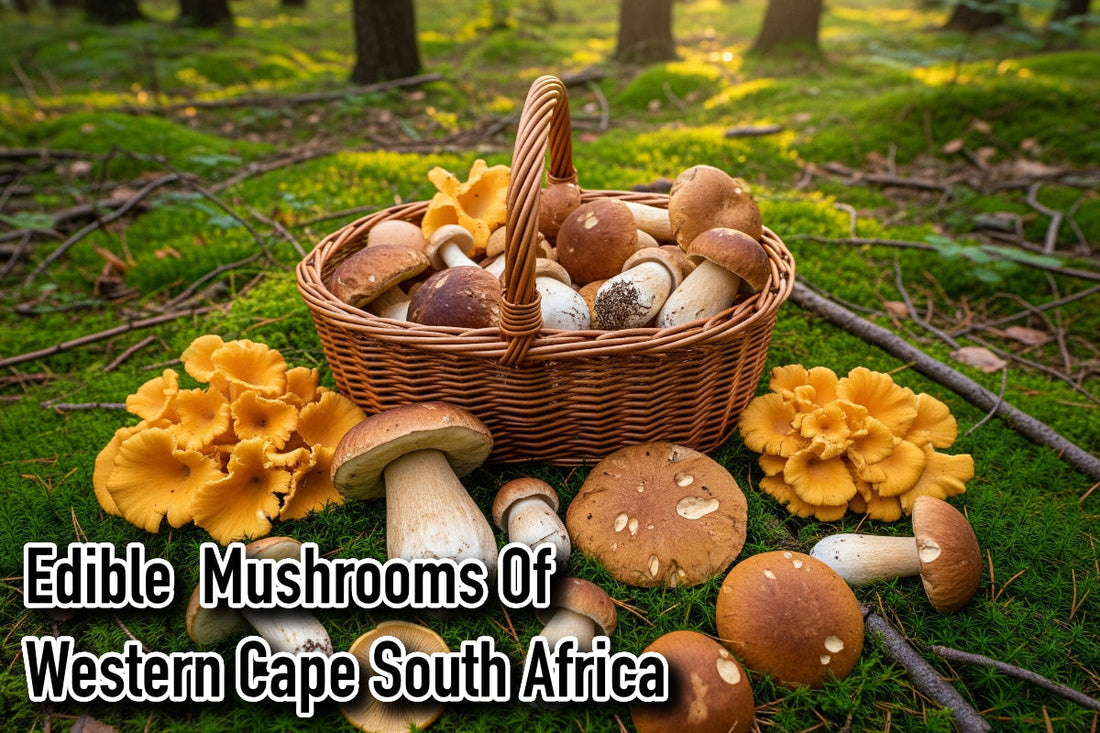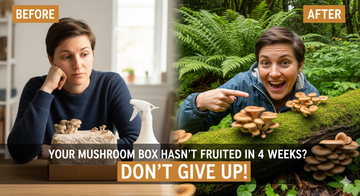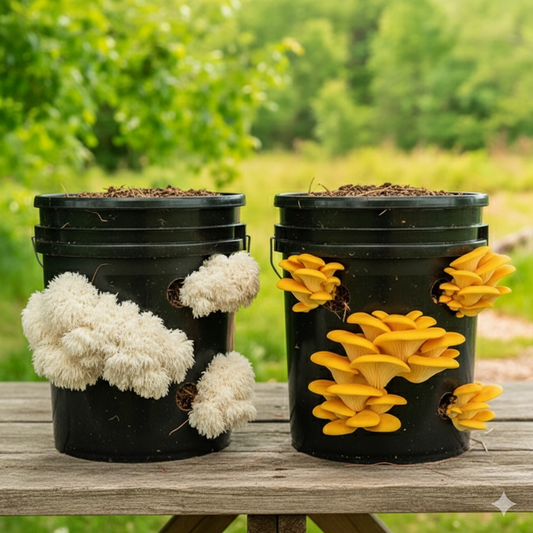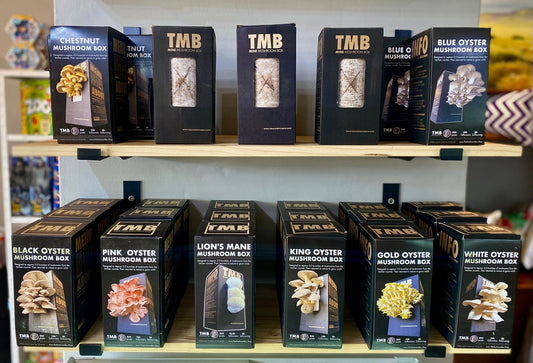
Edible Mushrooms We Found In South Africa ( Western Cape )
Welcome to our mushroom foraging guide!
Featuring edible mushrooms found in South Africa (Western Cape).
Disclaimer: If it's you're new to foraging for a certain type of mushroom, always get a professional opinion before consuming it. Take clear images of the top, bottom and surroundings. Post those onto a Facebook Group like: Mushrooms of the Western Cape, where a specialized mycologist can advise you.

Since we've started our seasonal mushroom workshops, we've decided to create a list of the favorite edible mushrooms you can find in south Africa so that you're armed with the knowledge necessary to find edible mushrooms in your local forests.
In this blog you'll learn how to identify some of our favorite mushrooms in the wild, as well as precautions wed advise you to take.
1. South Africa’s Stunning Purple Mushroom:
Scientific Classification
Kingdom: Fungi
Class: Agaricomycetes
Order: Agaricales
Family: Tricholomataceae
Genus: Clitocybe
Species: Clitocybe nuda
What Makes the Wood Blewit So Special?
The Wood Blewit, also known as the Blue Stalk mushroom, is a true woodland treasure. Its striking purple to lilac hues make it one of the most visually captivating edible mushrooms you’ll find in South African forests. This mushroom stands out not just for its color, but also for its unique aroma—often described as reminiscent of frozen orange juice, a helpful clue to distinguish it from toxic look-alikes.
How to Identify Wood Blewits Safely
Cap: Convex or slightly umbonate (a gentle bump in the center) with a smooth purple surface.
Gills: Lilac to pale purple, closely spaced beneath the cap.
Stipe (Stem): Short, stout, and bare, matching the cap’s purple tones.
Spore Print: White to pale pink—an important feature to differentiate it from poisonous Cortinarius species, which have rusty brown spores.
Ecology: Saprotrophic, meaning it feeds on decaying organic matter, commonly found in woodlands and leaf litter.
Why Forage for Wood Blewits?
Not only are Wood Blewits a beautiful addition to your mushroom collection, but they’re also delicious and edible when cooked properly. Their firm texture and mild flavor make them a versatile ingredient in soups, sautés, and stews.
Important Safety Tip
While Wood Blewits are edible, they can sometimes be confused with certain purple Cortinarius species, which are poisonous. Always rely on multiple identification features—especially spore print color and smell—before consuming wild mushrooms.
2. The Saffron Treasure of South African Pine Forests
Pine Ring (Lactarius deliciosus):
Scientific Classification
Kingdom: Fungi
Class: Agaricomycetes
Order: Russulales
Family: Russulaceae
Genus: Lactarius
Species: L. deliciosus
Meet the Pine Ring: South Africa’s Most Sought-After Edible Mushroom
The Pine Ring, also known as the Saffron Milk Cap, is a true gem for foragers and foodies alike. Instantly recognizable by its vibrant orange color and concentric ring markings, this mushroom is a highlight of South Africa’s pine forests during the cooler months. Its cap starts off convex and in-rolled when young, flattening out as it matures, and can grow anywhere from 4 to 15 centimeters across.
Break open a Pine Ring and you’ll see its signature orange-red “milk” ooze out, while handling it often stains your fingers a deep green. The stipe (stem) is typically hollow and matches the cap’s orange hue, and the gills are crowded, running slightly down the stem—a feature known as decurrent gills.
Where & When to Find Pine Rings in South Africa
Pine Rings love the company of pine trees and are most often found in coniferous forests with well-drained soils. In South Africa, they flourish in the Western Cape from late autumn through winter (typically May to July), especially after good rains followed by sunny days. Popular foraging spots include Newlands Forest, Cecilia Forest, Constantia Nek, and Coetzenberg hiking trails around Cape Town.
How to Identify the Pine Ring
Cap: Bright orange, 5–15cm, with darker concentric rings; in-rolled when young, flattens with age
Gills: Crowded, slightly decurrent, pale orange
Stipe: Orange, hollow, often stains green when handled
Spore Print: Tan
Milk: Exudes orange-red latex when cut
Ecology: Mycorrhizal—grows in symbiosis with pine tree roots.
Foraging Responsibly: Sustainability Matters
To protect our forests and ensure future harvests:
Only pick mushrooms you can confidently identify as Pine Rings.
Harvest mature mushrooms, leaving younger ones to grow and spread spores.
Use a knife or scissors to cut the mushroom at the base, and gently cover the spot with soil.
Follow the “Rule of Thirds”: only take one-third of the mushrooms you find, leaving the rest for nature and fellow foragers.
Culinary Delights: Why Pine Rings Are a Choice Edible
Pine Rings are celebrated for their firm texture and rich, earthy flavor with a subtle hint of fruitiness. They’re delicious sautéed in butter, added to stews, or grilled over an open flame. Their vibrant color and unique taste make them a prized ingredient in kitchens across the world.
Quick Facts
Edibility: Choice
Cap Shape: Depressed or convex, with in-rolled edges when young
Habitat: Pine forests, especially in the Western Cape
Season: May–July (after good rains)
3. One of South Africa’s Forest Favorites

Bay Boletus (Bay Bolete)
Quick ID Guide
Scientific Name: Boletus badius (also known as Imleria badia)
Cap: Chestnut to dark brown, convex when young, flattening with age, 5–15 cm wide
Pores: Cream to pale yellow when young, turning greenish-yellow as they mature; pores about 0.8–1.5 cm deep
Stem: Smooth, cylindrical, 4–9 cm tall, 1–2 cm thick, paler than the cap with occasional rose tints
Spore Print: Olive
Ecology: Mycorrhizal — grows in symbiosis with pine and other trees
Where & When to Find Bay Boletus in South Africa
Bay Boletus mushrooms love pine and mixed forests, popping up on forest floors or near decaying wood. In South Africa, they’re most common during the cooler, wetter months after rain, especially in shady, humid spots like pine plantations and wooded areas around the Western Cape.
Why Foragers Love the Bay Boletus
This mushroom is prized for its firm texture and mild, nutty flavor. It’s a great choice for beginners because it’s less likely to be infested by insects compared to other boletes. Plus, the pores on the underside easily separate from the flesh, making preparation simple.
Cooking Tip
Sauté Bay Boletus in butter or olive oil with garlic and herbs like thyme or rosemary for a quick, delicious side dish. They’re also fantastic in risottos, pasta, or hearty stews.
4. South Africa’s Colorful Forest Healer

Turkey Tail Mushroom (Trametes versicolor)
Quick ID Guide
Scientific Name: Trametes versicolor
Cap: Flat with concentric, multicolored bands in rusty brown, grey, black, and sometimes hints of blue or green (from algae on older specimens)
Texture: Thin, leathery, and velvety to the touch
Underside: White to light brown with tiny pores (not gills!)
Spore Print: White to yellow
Stipe: None (grows directly attached to wood)
Ecology: Saprotrophic — grows on dead hardwood logs and tree stumps
Where & When to Find Turkey Tail in South Africa
Turkey Tail mushrooms can be found year-round on decomposing hardwood logs in forests and wooded areas. Look for them in shaded, damp spots where fallen trees or branches are breaking down, especially in the Western Cape and other temperate regions.
Why Foragers & Herbalists Love Turkey Tail
Though not tasty enough to eat raw or cooked, Turkey Tail is famous for its powerful health benefits. It supports immune function, digestive health, and overall wellness, making it a popular choice for teas, tinctures, and supplements. Its vibrant colors and unique fan shape also make it easy to spot once you know what to look for.
How to Spot the Real Turkey Tail (vs. Look-Alikes)
Flip the mushroom over: true Turkey Tail has tiny pores underneath, not a smooth surface.
Check for distinct, colorful concentric rings on the cap.
Feel the cap surface—it should be velvety or slightly hairy.
The mushroom should be thin and flexible, not thick or brittle.
Look for a white edge along the margin of the cap.
Quick Tip for Beginners
Carry a small hand lens to see the tiny pores underneath clearly—it’s a fun tool that helps you identify Turkey Tail and other mushrooms with confidence!
5. The Tough, Scaly Conifer Specialist
Train Wrecker Mushroom (Neolentinus lepideus)
Quick ID Guide
Scientific Name: Neolentinus lepideus
Cap: Whitish to cream with coarse brown scales, 3–12 cm wide, convex with rolled edges when young, flattening with age
Gills: White to off-white, closely spaced, serrated (saw-like edges), attached to the stem (adnate to decurrent)
Stem: 2.5–15 cm tall, 1–2 cm thick, covered with brown rectangular scales, sometimes with a ring that may disappear
Flesh: Tough, white, sometimes yellowing in the stem, with a faint licorice-like smell
Spore Print: White
Ecology: Saprotrophic – grows on dead or decaying conifer wood, including pine stumps, logs, and even treated lumber
Where & When to Find Train Wreckers in South Africa
Train Wreckers are usually found on dead conifer wood, especially pine, thriving on stumps, fallen branches, and sometimes old lumber. They appear from early summer through late autumn, favoring shady, damp forest areas and pine plantations. Be cautious—avoid mushrooms growing on treated wood like railway sleepers, as they can absorb toxins.
Why Foragers Like the Train Wrecker
This mushroom is a hardy decomposer known for its distinctive scaly cap and serrated gills (hence the nickname “scaly sawgill”). While the flesh is tough, young specimens are edible and can be cooked, though they’re not as popular for flavor as some other mushrooms. Its unique look makes it easy to identify once you know what to look for.
How to Spot the Train Wrecker
Look for a white or cream cap covered in coarse brown scales, especially dense near the center.
Check the gills underneath—train wreckers have serrated, saw-like edges, unlike similar mushrooms with pores or teeth.
The stem is scaly and may have a ring, but it can wear off with age.
Smell the mushroom—it often has a faint anise or licorice scent.
Quick Tip
Avoid eating train wreckers growing on treated wood or polluted areas. Stick to clean, natural forest sites for safe foraging.
6. South Africa’s Bright Purple Forest Pepper

Cape Russula (Russula capensis)
Quick ID Guide
Scientific Name: Russula capensis
Cap: Varies from pink-purple to deep purple-red, concave when mature, fairly large and brightly colored
Gills: White to dark yellow, free from the stem and hanging slightly from the cap edge
Stem: Bare, smooth, usually white or pale
Spore Print: White to dark yellow
Ecology: Saprotrophic – grows by decomposing organic matter on the forest floor
Where & When to Find Cape Russula in South Africa
Cape Russula mushrooms are common in South African forests, especially in pine plantations and mixed woodlands. They pop up on the ground during the rainy, cooler months, often blending beautifully with the forest floor thanks to their vibrant purple hues.
Why Foragers Love the Cape Russula
This mushroom is easy to spot thanks to its bright purple to red cap and distinctive gills that detach from the stem. It’s a choice edible with a mild flavor, making it a popular find for mushroom hunters. Plus, its brittle “snap test” stem helps confirm ID—break it like chalk!
Cooking Tip
Cape Russulas are great sautéed with garlic and herbs or added to creamy sauces. Their firm texture holds up well in stews and pasta dishes.
7. South Africa’s Bright & Tasty Summer Mushroom

Chicken of the Woods (Laetiporus spp.)
Quick ID Guide
Scientific Name: Laetiporus sulphureus and related species
Cap: Bright yellow to orange, often with wavy, overlapping shelf-like brackets, 5–25 cm wide
Texture: Soft and fleshy when young, becoming tough and brittle as it ages
Underside: Covered in tiny pores (not gills), pale yellow to white
Spore Print: White
Growth: Grows in large clusters on living or dead hardwood trees like oak, chestnut, and poplar (avoid pine or blue gum)
Ecology: Parasitic and saprotrophic — breaks down wood, often on oak and similar trees
Where & When to Find Chicken of the Woods in South Africa
Chicken of the Woods mushrooms are a warm-season favorite, most prolific from January to March. They grow mostly on oak, chestnut, and poplar trees in forests and wooded areas. Unlike many mushrooms, they don’t need rain to fruit and can often be spotted by their bright orange-yellow “pancake” shelves growing on tree trunks or fallen logs.
Why Foragers Love Chicken of the Woods
This mushroom is a great choice for beginners thanks to its bold colors and easy-to-spot shelf shape. It’s famous for its chicken-like texture and mild flavor, making it a delicious meat substitute. Plus, it’s packed with protein and medicinal benefits. Just remember: always cook it well, as eating raw can cause stomach upset.
How to Spot Chicken of the Woods
Look for bright yellow-orange overlapping shelves growing in clusters on hardwood trees.
The underside has tiny pores, not gills.
Young mushrooms are soft and moist; older ones get brittle and pale.
Avoid mushrooms growing on pine or blue gum—they can cause adverse reactions.
Cooking Tip
Harvest young, tender Chicken of the Woods and sauté with garlic and herbs for a tasty, meaty dish. It’s perfect in stir-fries, soups, or grilled as a vegetarian main.
8. South Africa’s Tough, Fan-Shaped Wood Dweller

(Schizophyllum commune)
Quick ID Guide
Scientific Name: Schizophyllum commune
Cap: Small (1–4.5 cm), fan-shaped or shell-like, whitish to grey with a dense hairy/furry surface
Gills: Unique “split” gills that look like folded leaves or a Chinese fan; grey to pale reddish, split lengthwise and able to close in dry weather
Stem: None or very short; attached directly to wood
Spore Print: White
Ecology: Saprotrophic — grows on dead hardwood and sometimes conifer wood
Where & When to Find Split Gill Mushrooms in South Africa
Split Gills are common year-round on dead or decaying hardwood branches, fallen logs, and cut timber. They thrive in forests and wooded areas, especially where there’s plenty of dead wood to break down. Look for them in shady, damp spots from autumn through spring.
Why Foragers & Nature Lovers Admire Split Gills
Though small and tough, Split Gills are fascinating because of their unique “split” gills that protect spores during dry spells by closing up, then reopen when moisture returns. They’re edible but tough and chewy, often used in traditional medicines and teas rather than cooking. Their ability to survive harsh conditions makes them one of the most widespread mushrooms on Earth!
How to Spot Split Gills
Look for small, fan-shaped mushrooms with a furry white or grey cap attached directly to wood.
Check the underside: the gills are split lengthwise and can close up when dry.
The mushroom feels tough and leathery, not soft or fleshy.
No visible stem—just a cap attached flat to the wood.
Quick Tip
Carry a hand lens to see the split gills clearly—they’re a cool feature that sets this mushroom apart from others on dead wood.
We hope this information was helpful! If you have any questions or have found some mushrooms you'd like us to help you identify, send us a message on:
Where we've posted a whole bunch of mushroom photos and blogs you might enjoy!
Thanks for your interest in mushrooms! If you're based in Cape Town, South Africa & would like to join us on our next mushroom workshop, take a look at our seasonal mushroom workshops. We hope to see you there!
No comments










0 comments